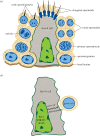Transcription and post-transcriptional regulation of spermatogenesis
- PMID: 20403875
- PMCID: PMC2871917
- DOI: 10.1098/rstb.2009.0196
Transcription and post-transcriptional regulation of spermatogenesis
Abstract
Spermatogenesis in mammals is achieved by multiple players that pursue a common goal of generating mature spermatozoa. The developmental processes acting on male germ cells that culminate in the production of the functional spermatozoa are regulated at both the transcription and post-transcriptional levels. This review addresses recent progress towards understanding such regulatory mechanisms and identifies future challenges to be addressed in this field. We focus on transcription factors, chromatin-associated factors and RNA-binding proteins necessary for spermatogenesis and/or sperm maturation. Understanding the molecular mechanisms that govern spermatogenesis has enormous implications for new contraceptive approaches and treatments for infertility.
Figures


Similar articles
-
The role of molecular chaperones in spermatogenesis and the post-testicular maturation of mammalian spermatozoa.Hum Reprod Update. 2012 Jul;18(4):420-35. doi: 10.1093/humupd/dms009. Epub 2012 Apr 20. Hum Reprod Update. 2012. PMID: 22523110 Review.
-
The application of proteomic approaches to the study of mammalian spermatogenesis and sperm function.FEBS J. 2013 Nov;280(22):5635-51. doi: 10.1111/febs.12461. Epub 2013 Sep 2. FEBS J. 2013. PMID: 23902417 Review.
-
Testis-specific transcription mechanisms promoting male germ-cell differentiation.Reproduction. 2004 Jul;128(1):5-12. doi: 10.1530/rep.1.00170. Reproduction. 2004. PMID: 15232059 Review.
-
Aquaporin biology of spermatogenesis and sperm physiology in mammals and teleosts.Biol Bull. 2015 Aug;229(1):93-108. doi: 10.1086/BBLv229n1p93. Biol Bull. 2015. PMID: 26338872 Review.
-
[Regulation of gene expression during spermatogenesis at transcriptional level].Yi Chuan. 2011 Dec;33(12):1300-7. doi: 10.3724/sp.j.1005.2011.01300. Yi Chuan. 2011. PMID: 22207375 Review. Chinese.
Cited by
-
RFX2 Is a Major Transcriptional Regulator of Spermiogenesis.PLoS Genet. 2015 Jul 10;11(7):e1005368. doi: 10.1371/journal.pgen.1005368. eCollection 2015 Jul. PLoS Genet. 2015. PMID: 26162102 Free PMC article.
-
Expression of TRPV1 as A Heat Sensitive Voltage-Dependent Ion Channel and Oxidative Stress in Sperm Samples of Infertile Men with Varicocele: A Case-Control Study.Cell J. 2022 Jun;24(6):323-329. doi: 10.22074/cellj.2022.8038. Epub 2022 Jun 29. Cell J. 2022. PMID: 35892235 Free PMC article.
-
Control of messenger RNA fate by RNA-binding proteins: an emphasis on mammalian spermatogenesis.J Androl. 2012 May-Jun;33(3):309-37. doi: 10.2164/jandrol.111.014167. Epub 2011 Jul 14. J Androl. 2012. PMID: 21757510 Free PMC article. Review.
-
The testis-specific double bromodomain-containing protein BRDT forms a complex with multiple spliceosome components and is required for mRNA splicing and 3'-UTR truncation in round spermatids.Nucleic Acids Res. 2012 Aug;40(15):7162-75. doi: 10.1093/nar/gks342. Epub 2012 May 8. Nucleic Acids Res. 2012. PMID: 22570411 Free PMC article.
-
Telomere homeostasis in mammalian germ cells: a review.Chromosoma. 2016 Jun;125(2):337-51. doi: 10.1007/s00412-015-0555-4. Epub 2015 Nov 2. Chromosoma. 2016. PMID: 26525972 Review.
References
-
- Ackerman S. L., Kozak L. P., Przyborski S. A., Rund L. A., Boyer B. B., Knowles B. B.1997The mouse rostral cerebellar malformation gene encodes an UNC-5-like protein. Nature 386, 838–842 (doi:10.1038/386838a0) - DOI - PubMed
-
- Akerfelt M., Henriksson E., Laiho A., Vihervaara A., Rautoma K., Kotaja N., Sistonen L.2008Promoter ChIP-chip analysis in mouse testis reveals Y chromosome occupancy by HSF2. Proc. Natl Acad. Sci. USA 105, 11 224–11 229 (doi:10.1073/pnas.0800620105) - DOI - PMC - PubMed
-
- Bannister A. J., Kouzarides T.2005Reversing histone methylation. Nature 436, 1103–1106 (doi:10.1038/nature04048) - DOI - PubMed
-
- Bannister A. J., Schneider R., Kouzarides T.2002Histone methylation: dynamic or static? Cell 109, 801–806 (doi:10.1016/S0092-8674(02)00798-5) - DOI - PubMed
-
- Barski A., Cuddapah S., Cui K., Roh T. Y., Schones D. E., Wang Z., Wei G., Chepelev I., Zhao K.2007High-resolution profiling of histone methylations in the human genome. Cell 129, 823–837 (doi:10.1016/j.cell.2007.05.009) - DOI - PubMed
Publication types
MeSH terms
LinkOut - more resources
Full Text Sources

